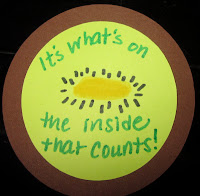"It's What's on the Inside That Counts!"
I am currently running a group for children with a loved one in jail. One of the activities I have facilitated with my group is the kiwi lesson. The kiwi lesson can be used to address many different topics including stigma, shame, diversity, tolerance, body image, and more. This lesson is fun and engaging. It worked especially well in the context of this group.
The idea for the kiwi lesson comes from The Freedom Writers Diary Teacher's Guide by Erin Gruwell. In the book there is a lesson called the "Peanut Game." I decided to use a kiwi instead of peanuts because of how colorful kiwis are on the inside and to avoid any allergies.
by Erin Gruwell. In the book there is a lesson called the "Peanut Game." I decided to use a kiwi instead of peanuts because of how colorful kiwis are on the inside and to avoid any allergies.
The idea for the kiwi lesson comes from The Freedom Writers Diary Teacher's Guide
 At the beginning of the activity I pass out a kiwi to each child. I instruct students to explore the outside of the kiwi and to make a list of as many adjectives as they can that describe the kiwi. I recommend having students pair up to do this part with one student recording the words at a time. After everyone has come up with the list for the outside of the kiwi, I ask students to share some of the adjectives they come up with. Students usually use words such as ugly, hairy, gross, creepy, etc.
At the beginning of the activity I pass out a kiwi to each child. I instruct students to explore the outside of the kiwi and to make a list of as many adjectives as they can that describe the kiwi. I recommend having students pair up to do this part with one student recording the words at a time. After everyone has come up with the list for the outside of the kiwi, I ask students to share some of the adjectives they come up with. Students usually use words such as ugly, hairy, gross, creepy, etc.
I then pass out plates, plastic knives and plastic spoons to the children. I instruct them to cut the kiwi in half and scoop the center out with a spoon to taste it. I then instruct students to record a list of words that describe the inside of the kiwi and how it tastes. I again ask students to share their adjectives with the group. Students use words like sweet, sour, bright, tasty, colorful, cheerful, etc.
At this point, I ask students to explain what they notice about their two lists of adjectives. Someone usually points out that the words for the outside are negative and the words for the inside are more positive. Students usually also say something like "If I just looked at the kiwi, I wouldn't eat it," or "It tastes really good but you wouldn't know that by looking at it."
This begins a discussion about being judged and stigma. We talk about how people sometimes make assumptions about each other because of how they look or the way they dress. Students share stories about times they were judged by the way they dress, how dark or light their skin is, their religion, background, ethnicity, etc.
I ask students what they think the take-away message is for this lesson. Students say "Don't judge someone by the outside," and "It's what's on the inside that counts!"
I wanted students to be able to have a keepsake from the lesson so I cut out brown circles and bright green circles
and bright green circles out of card stock
out of card stock using my cricut
using my cricut . After the lesson, students were glued their kiwi pieces together and decorated the inside of the kiwi with seeds. I invited them to write a message they learned from the lesson on their kiwi.
. After the lesson, students were glued their kiwi pieces together and decorated the inside of the kiwi with seeds. I invited them to write a message they learned from the lesson on their kiwi.
I wanted students to be able to have a keepsake from the lesson so I cut out brown circles
 |
| Card stock circles |
 |
| Completed kiwi |
What lessons do you facilitate that teach students, "It's what's on the inside that counts!"? Comment below, email me, tweet, or share on the School Counselor Blog Facebook Page!
Danielle is a K-12 Certified School Counselor, Nationally Certified Counselor, and blogger at School Counselor Blog, a place where school counselors share innovative ideas, creative lesson plans, and quality resources. Contact Danielle via email, follow her on twitter, and become a fan of the School Counselor Blog Facebook Page.



